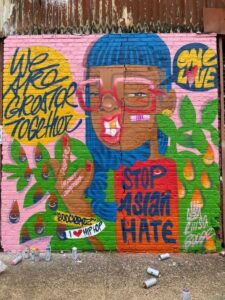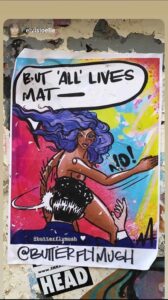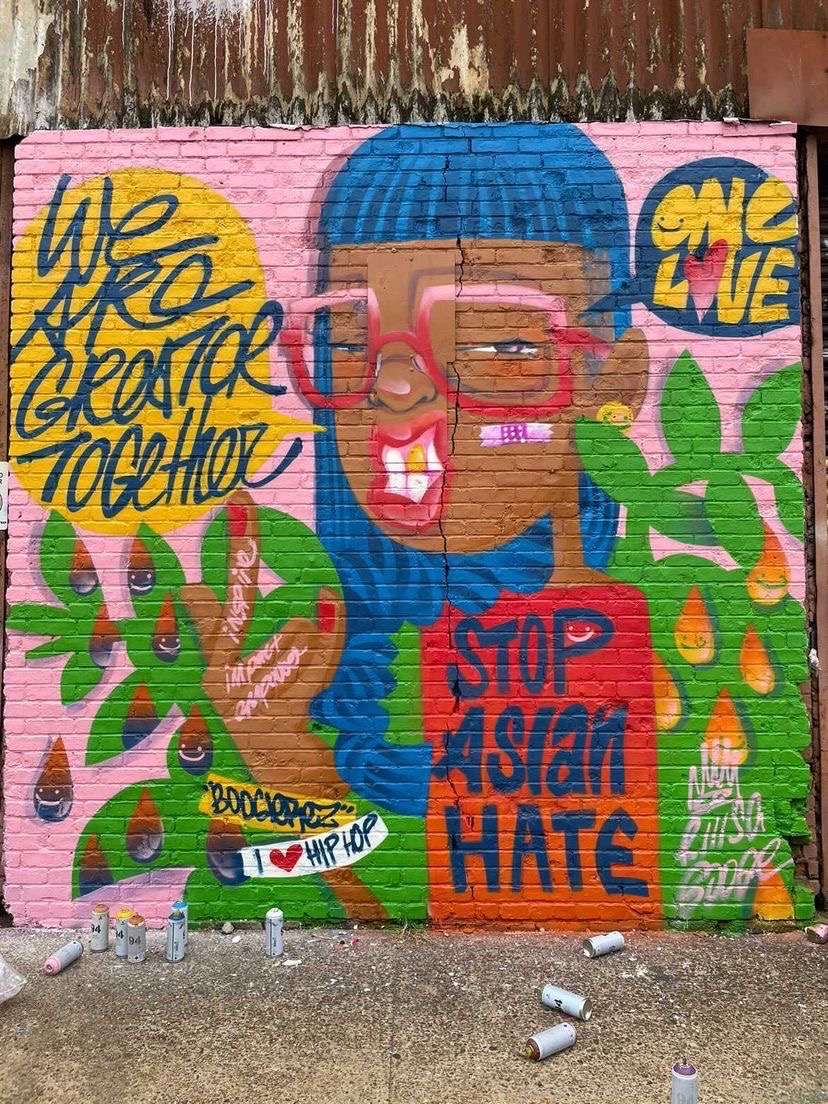The summer of 2020 changed Andrea Acevedo’s art. The murder of George Floyd stirred something deep within her – standing amongst a crowd of hundreds of protesters in New York City, defending Black lives, surrounded by people dedicated to equality and the liberation of all oppressed people, she asked herself, “How can I help?”
And so she took to the streets and painted the walls with colors of unity. Other female POC allies followed suit – she wasn’t the only street artist moved by the pandemic, election, and the protests of 2020.
Across from the Anchored Inn in Bushwick, Brooklyn, a freshly painted mural with bright colors and an even brighter message read: “We Are Greater Together. Stop Asian Hate.” The proud creator is Risa Tochigi, aka Riiisa Boogie.

“When I was younger, I never really had a voice,” Riiisa said in a phone interview.
When she was 7, Riiisa’s family emigrated to America, but her parents still expected her to behave in what she considers a Japanese way: Don’t make waves. Work hard. Study hard. Repeat.
In her late teenage years, she met people in the creative field who introduced her to “The Streets.” Her partner taught her how to spray paint, and for the first time in her life, she felt like she had something to say. Inspired by rock and roll, Riiisa decided that graffiti was her medium, and New York City is her blank canvas.
For Riiisa, street art felt like the most “raw and organic” form of expression. The entire concept of using a wall to spread information and awareness about the BLM and feminist movements fascinated her. But before last summer, she didn’t venture into themes surrounding social justice. However, the murder of George Floyd and the events that followed changed her worldview.
“Now it’s like if I don’t say something, it’s almost like saying nothing,” Riiisa explained. “My art has helped me to become more confident in who I am as an Asian woman.”
As an artist, she wants to have fun and explore the streets of the city. But as an Asian woman in 2021, she aspires to inspire, impact, and empower others in need.
“I am still growing and learning about how to put that [information and awareness] out, but this is hip-hop culture, you know: peace, unity, love, and having fun!”
Although New York City is considered the birthplace of hip-hop culture, it has struggled to spread peace, unity, and love. Between February to September 2020, the city’s Commission on Human Rights received 566 reports of discrimination, harassment, and assault related to COVID-19, out of which 184 appeared to be anti-Asian in nature.
In November 2020, Amanda Phingbodhipakkiya, a New York City Public Artist in Residence, worked with the Commission on a series titled “I Still Believe in Our City.” The series included an array of colorful portraits of Black, Asian, and Pacific Islander women alongside anti-discriminatory captions like, “I did not make you sick” and “I am not your scapegoat.”

Amy Young is a professor of Art History at the City University of New York (CUNY) who teaches a course on the history of street art – from Tats Cru to Banksy. Over the years, her class has met over 40 artists and collaborators who have given the students a sneak peek into the world of graffiti.
“I have never seen the movement so powerful,” said Professor Young. “It is the biggest art movement ever. Bigger than the Renaissance, bigger than Abstract Expressionism. I hope it is maintained.”
And those on the streets agree.
“I think street art has always been political. I just don’t think that we ever looked at it that way,” said Acevedo, who goes by the name “Butterfly Mush.” “Kids in the 70s who were hanging off subway trains and painting the subway carts – that was political. That was just kids from underserved communities lashing out and speaking out saying, “Hey, notice me! I am here!”
Mush believes that we all could benefit from daily visual reminders. So the next time you walk around East Village and come across a mural: Stop. Read. Reflect.








